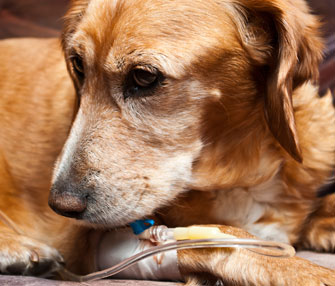Making Decisions Around Cancer Treatment and Costs
Published on November 13, 2012
Skip To

The New York Times recently published an article written by Memorial Sloan-Kettering Cancer Center oncologists about how the escalating cost of cancer drugs adds a new obligation to the physician’s side of the conversation regarding cancer care: the consideration for the financial impact of the recommended treatment on the patient and their family.
In the spirit of Zoobiquity, which is a recently promoted concept that encourages the sharing of medical knowledge across species and disciplines, veterinarians can teach physicians a few tricks about rolling money, prognosis and quality of life into one conversation. We veterinarians have a lot of experience in this realm since in my oncology practice, pets with cancer and insurance are still as scarce as hen’s teeth, and discussions about finances occur every day in my clinic.
Same Drugs, Different Species, Different Choices
Mayo Clinic physicians recently detailed why cancer treatments are so costly. The expense of human chemotherapy agents also directly impact dog and cat cancer treatment; there are only two cancer drugs specifically approved for use in dogs and not a single cancer drug approved for use in cats. The lack of veterinary-approved chemotherapy drugs means veterinary oncologists purchase drugs to treat your favorite fur person from the same suppliers as do the oncologists at the Mayo Clinic or Memorial Sloan-Kettering Cancer Center. Not all human cancer drugs work in pets, but many do. Really expensive drugs like the ones discussed in the recent articles are typically not used in canine and feline patients, as cost prohibits their use.New Is Not Necessarily Better
In the New York Times article I mentioned earlier, the authors lament the approval of expensive new drugs that are not therapeutically superior to old drugs. Ours is a society that values new over old. This value, in part, drives consumer’s desire for new products such as novel chemotherapy drugs. Yet, every day, veterinarians successfully use “old” and, yes, cheaper drugs to treat cancer in their animal patients..Let’s look at my patient Truffy who, like many geriatric pets, has multiple problems including a messy, bleeding mast cell tumor. Mast cells are involved in the body’s immune system and are typically found in tissues such as the skin, digestive, and respiratory systems where they mount an inflammatory response when things go awry. Sometimes, however, this response gets out of hand and an invasive tumor forms. His family and I decided radiation and surgery were not good options for him. Treatment with an inexpensive steroid was our first choice. However, it did not shrink the mast cell tumor one millimeter. We discussed other options and decided to try a somewhat more expensive but older chemotherapy agent. This drug, which has been in use since 1984, has successfully controlled Truffy’s tumor for the past several months while improving his quality of life. It turned out to be the right option for this pet and his family, and having those kinds of choices is what is key when dealing with cancer.
Consider Various Treatments
I am an options kind of person. Only once in a blue moon would I tell a dog or cat owner how to treat their pet with cancer. Instead, I like to outline the treatment options available for their pet’s tumor, and then discuss how each one ranks in terms of survival, anticipated side effects and, yes, cost.Here is how a typical discussion goes for a pet with lymph node cancer, technically called lymphoma. This kind of cancer cannot be cured in dogs and cats, but treatment can improve both the quality and quantity of time you and your family have with your pet.
Option 1 is not to treat the cancer, and the pet will live only a couple of months.
Option 2 is a deluxe multidrug chemotherapy protocol that can give pets a good quality of life on average for about one year. With option 2, I will need to see my client approximately 30 times in that year. It is the most expensive treatment option, but it offers the best chance for your pet’s long-term survival.
Option 3, for dogs with lymphoma, is treatment with a single drug that has a good chance of inducing remission, costs less, requires fewer visits and may have a lower risk of side effects. Survival time will not be as long as with the deluxe protocol.
Then we come to option 4. Sometimes pets with lymphoma are so sick, I take a big gulp and discuss euthanasia the first time I meet the pet’s family.





